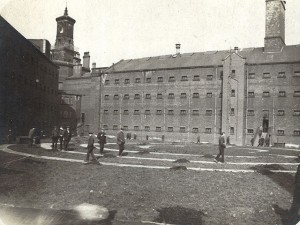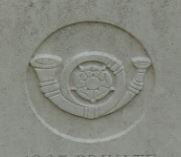Wakefield Express WW1 – George A Lister

Wakefield prison c1916 possibly with CO’s exercising
George Arthur Lister. He seems to have been born around 1879 in Wakefield, the son of Edward Lister. Edward earned his living as a prison warder and in the 1901 census he was with his wife Emily, sons Alfred, George A and Frederick along with Henry Taylor their grandson. Home was 4 Silcoates Street. George at the time was 21 years old and employed as a postman.
By the time 1911 came around, George had married Mary Elizabeth, who had been transcribed as Amy Elizabeth by Ancestry. The couple were living at 4 Amery Cottage, George Street, Sandal. George and Mary, who came from Thorne, had been married 5 years ad had one child, five year old Edward. George now gave his occupation as tramway motor-man for the Electric Light Railway.
George had married Mary Elizabeth Yates on the 14th of August 1905 according to his service records with two children being named – Edward born on 24th of February 1906 in Wakefield and Dorothy born on the 4th of June 1914, also in Wakefield. The couple according to the military paperwork seem to have married in Bolton, but Freebmd have a marriage for the Doncaster area, which ties in with Mary being from Thorne.

K.O.Y.L.I. © C Sklinar 2015
Twelve months after the census of 1911, on the 19th of March 1912, George attested to the K.O.Y.L.I. Territorial Force (duplicate copy), giving his address as 4 George Street, Sandal (transcribed by Ancestry as Landal). His service number became 1569 and his Medal Card tells he became a corporal on the 27th of March 1913. His service records tell that he had done annual training, gained promotion to sergeant and during time in France performed the duties of C.S.M. in 1917. He was sent to France in April of 1915, coming home in December of the same year. But, by the summer of 1916 he was back in France.
A description of George brings him to life – he was tall for a man of the time being 6′ tall. He had a 39″ fully expanded chest, with good physical development and vision.
The original Attestation form confirms his address and occupation found earlier in the 1911 census. George signed on the 12th of September 1914 to serve in any place outside the United Kingdom in the event of a National emergency. By 1917, George had been transferred to the Loyal North Lancs. Regt., changing his service number to 27281.
It seems that somewhere along the line Mary Elizabeth moved from number 4 George Street, Sandal to number 7.
Going through the service records it appears that ion 24th December 1915, George was admitted to hospital. Then being sent to England via a hospital ship – could this be the reason he was home, returning to France in the summer of 1916? Shortly after returning to France, on the 21st of July 1916, his rank of Sergeant was confirmed. He was granted leave to the U.K. on 22nd of March for one week.
On the 22nd of June, George was evacuated to a field ambulance and rejoined the regiment the next day. By the 12th of July 1917 he was wounded on duty, but later on that month, the 31st, he was killed on duty. He rests in Voormezeele Enclosure No 3, grave XV C 10, along with over 1000 other casualties of war.
The Wakefield Express for the 28th of August 1917 tells:-
Sandal Sergeant’s Death – Killed by a Sniper. Another Sandal man has given his live for his King and Country. We refer to Sergt. George Arthur Lister, of the Loyal North Lancashire Regiment, who lived at 7, George Street, Sandal.
In a sympathetic letter to the widow, Second Lieut. Barker states ‘It is with great regret that I have to inform you of the death in action of your husband, Sergt. Lister. I feel his loss keenly, as he was an efficient N.C.O. and carried out all his duties punctiliously. He was generally admired for the manner in which he braved the extremely rough work of the trenches. It may be some poor consolation for you to know that he died without pain, being killed instantaneously by a bullet from the rifle of a sniper during operations on July 31st. Allow me, though a perfect stranger, to tender to you my sincere sympathy in your great bereavement.’
Mrs Lister has also received a letter from Q.M. S.T. O’Shaughnessy, who writing on behalf of the sergeant major and sergeants, says ‘I can assure you that your husband was well liked and respected by his colleagues and men alike. I can only add that he died a noble death fighting for a righteous cause, and we trust that the thought of that will be a little comfort to you in your sad bereavement.’
Sergt. Lister, who was well known in the Sandal district, was an old Territorial, being mobilised at the outbreak of war. He was previous to the war a tram-car driver in the employ of the West Riding (Yorkshire) Electric Tramways company. He leaves a widow and two children.
A man who seems to have been well respected in his community and by those who fought by his side.